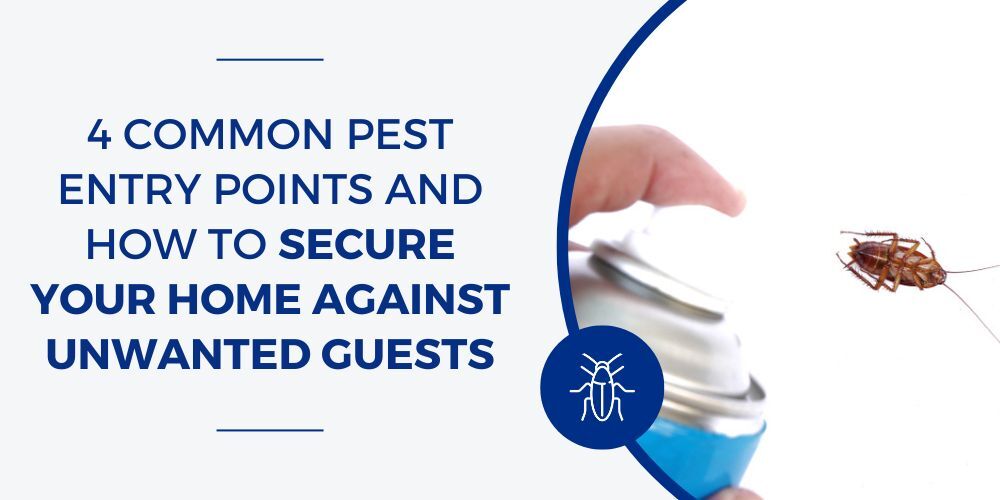When you spot pests in your home, it is common to wonder how these pests are getting in your home. The answer to this is quite simple: insects enter your house any way they can. Certain pests can squeeze between the small gaps, cracks and constricted openings. In this blog, we will discuss a few common entry points for pests to enter your home, enabling you to seal off these pests’ entry points and preventing your home from getting infested.
Common Entry Points for Pests
Cracks and Gaps in the Foundation
The foundation of your home is the direct contact of your home with the ground. If your home’s foundation has cracks, pests will likely take advantage of those and get into the walls. Cockroaches, ants, spiders, and termites often use small cracks and gaps in the foundation to get it. These insects are attracted to food, warmth, and moisture that can be found inside your home.
Unsealed Doors and Windows
Doors and windows are often the most common way for pests to get into your home. If the front doors of your house are not tightly sealed against the threshold, and if it allows even just a tiny gap of space, the pests can enter through it. If your windows or doors have wear and tear, which results in gaps, this could be the pest’s entry point to your house.
Taking advantage of daylight around doors or ripped window screens or gaps around frames, pests such as scorpions and roaches can get into your house easily.
Vents and Openings in the Roof
Many stucco homes have roof vents located close to the roof line. These vents play an important role in your house by allowing heat and moisture to escape the roof from the vent on the eve or roof to the ridge. If left unguarded, though, they may provide pests—especially roof rats—with access to the interior of your house.
Trees that hang over the roof or are near it are the most common cause of this. Rats scale the trees and then get into your house. They will then use an open vent to access the attic from that location.
Utility Lines and Pipes
While installing utilities in your home, the foundation is often penetrated, which makes these locations an entry point for pests. Termites often appear under sinks and behind toilets due to this.
Risks of Pest Infiltration
Pest infestations pose various risks to both property and human health, which makes protecting your home from pests important. Below are some key risks associated with pest infestations:
- Bites: Infiltration increases the chances of getting bitten by pests like fleas, bed bugs, and mosquitoes, which can hurt, itch, and sometimes even spread disease.
- Diseases: Several illnesses, including salmonella, hantavirus, Lyme disease, West Nile virus, and rat bite fever, can be transmitted by rodents and insects and pose a serious risk to human health.
- Poisoning: Poisonous bites from pests, such as spiders and scorpions, can cause serious injury or even death.
- Damage to wiring: Termites and rodents can chew through electrical wires, which raises the possibility of electrical fires and power supply issues.
- Destroying Insulation: Insects and rodents, in particular, can cause damage to insulation, decreasing its effectiveness and increasing energy consumption and costs.
- Damage to Wood: Termites often cause serious harm to wooden buildings, risking structural integrity and requiring expensive repairs.
- Damage to Plumbing: Rodents can chew down the pipes, which can lead to leaks that produce water damage and mold growth, which can be dangerous for health.
Securing Your Home: Practical Solutions
Foundation
Pest prevention tips are essential for maintaining a pest-resistant home. Start by conducting regular inspections of your home’s foundation. Look for cracks, gaps, or openings where pests could enter.
Use sealants to fill gaps and prevent pests from gaining access to your home. By sealing off entry points around the foundation, you can create a barrier preventing pests from infiltrating your living space.
Doors/Windows
You can install weatherstrippings to seal gaps around doors and windows and prevent pests from getting inside your house. Ensure that the screens on windows and doors are intact and are not torn or have holes. Intact screens act as a barrier, keeping pests like mosquitoes and flies out of your home while allowing fresh air to circulate.
Roof
Pests can also find their way into your home through the roof. Conduct regular inspections of your roof to look for damages or potential entry points for pests. Install mesh screens or covers over vents and openings to prevent pests from entering.
Utility Lines/Pipes
Seal any gaps in utility lines and pipes with steel wool or foam to prevent pests from entering through these entry points. Pests like rodents can squeeze through small openings around utility lines and pipes, so it’s essential to seal them off effectively.
DIY Pest Prevention Tips
- Proper Waste Management: The way you dispose of garbage and waste plays a major role in attracting pests to your home. Using tight-fitting bin lids and emptying them regularly helps in getting rid of the odor that attracts pests, enhancing your home’s pest resistance.
- Keeping Outdoors Clean: When you have a garden and greenery around your house, it is important to remove debris and trim down vegetation to stop pests from nesting and breeding. Clear leaves, get rid of standing water and other factors that might promote pests to protect your home from pests.
- Using Natural Repellents: Planting certain herbs and flowers can be helpful in repelling pests naturally, providing an effective barrier that protects your home from pests. For example, lavender, marigolds, and citronella can deter mosquitoes and other insects, integrating seamlessly with DIY pest control strategies.
- DIY Pest Control Products: You can utilize homemade or commercially available DIY pest control solutions to help manage minor pest issues. Solutions like vinegar sprays for ants or diatomaceous earth for cockroaches and fleas are cost-effective and reduce reliance on professional services.
Conclusion
Understanding the common pest entry points helps you to secure your home and protect it from pest infestation. By taking proactive steps to seal these entry points, you can notably reduce the likelihood of pest invasions.
If you are looking for effective DIY pest control products, Bug & Weed Mart can offer you a wide variety of it with expert advice. With about 4 decades of experience in assisting homeowners with their DIY pest control, Bug & Weed Mart is a one-stop solution to your DIY pest control needs.

